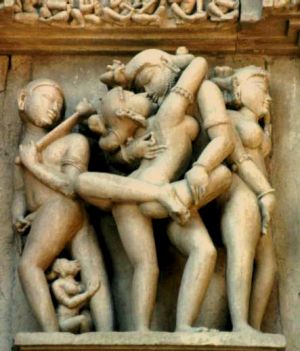Khajuraho Group of Monuments: Difference between revisions
meta>Anthony Bradbury No edit summary |
meta>Anthony Bradbury No edit summary |
||
| Line 34: | Line 34: | ||
[[Category:Cities and towns in Madhya Pradesh]] | [[Category:Cities and towns in Madhya Pradesh]] | ||
[[category:Hindu | [[category:Hindu holy cities]] | ||
[[de:Khajuraho]] | [[de:Khajuraho]] | ||
Revision as of 21:39, 5 June 2006

Khajuraho is a city in the Indian state of Madhya Pradesh, located in Chhatarpur District, about 385 miles (620 kilometres) southeast of Delhi, the capital city of India.
One of the most popular tourist destinations in India, Khajuraho has the largest group of medieval Hindu temples, famous for their erotic sculpture. The name Khajuraho is derived from the Hindi word khajur meaning date palm.
The city was once the religious capital of the Chandela Rajputs, a Hindu dynasty that ruled this part of India from the 10th to the 12th centuries. The Khajuraho temples were built over a span of a hundred years, from 950 to 1050. The whole area was enclosed by a wall with eight gates, each flanked by two golden palm trees. There were originally over 80 Hindu temples, of which only 22 now stand in a reasonable state of preservation, scattered over an area of about 8 square miles (21 km²).
The temples of Khajuraho are an example of religion laced with erotica. They are fine examples of Indian architectural styles that have gained popularity due to their salacious depiction of the traditional way of life during medieval times. They were rediscovered only during the 20th century and the jungles had taken a toll on some of the monuments.
The Khajuraho group of monuments has been listed as a UNESCO World Heritage Site.
Architecture
Khajuraho temples, constructed with spiral superstructures, adhere to northern Indian shikhara temple style and often to a Panchayatana plan or layout. A few of the temples are dedicated to the Jain pantheon and the rest to Hindu deities - to God's Trio, Brahma, Vishnu and Shiva, and various Devi forms. A Panchayatana temple had four subordinate shrines on four corners and the main shrine in the center of the podium, which comprises their base.The temples are grouped into three geographical divisions : western, eastern and southern
With a graded rise secondary shikharas (spires) cluster to create appropriate base for the main shikhara over the sanctum. Kandariya Mahadeva, one of the most accomplished temples of the Western group, comprises eighty-four shikharas, the main being 116 feet from the ground level. These shikharas - subordinate and main, attribute to the Khajuraho temples their unique splendor and special character. With a graded rise of these shikharas from over the ardhamandapa, porch, to mandapa, assembly hall, mahamandapa, principal assembly hall, antarala, vestibule, and garbhagraha, sanctum sanctorum, Khajuraho temples attain the form and glory of gradually rising Himalayan peaks.
Landscape
The Khajuraho temples are now set in a parkland landscape. When India gained independence from Britain in 1947 the landscape setting was semi-desert and scrub. The archaeological park now has something of the character of an English public park, with mown grass, rose beds and ornamental trees. This may be popular with visitors but has no relationship with the historic landscape at the time the temples were built. The development of landscape archaeology as an academic discipline raises questions concerning the landscape of archaeology of Khajuraho and the original relationship between the temple complex and the surrounding area. There are no records of what the original landscape might have been but it is known that a large community of priests used the temple complex and that Indian gardens in the tenth century were predominantly tree gardens. They did not have lawns or herbaceous flowering plants.
See also
External links
- Photos of Khajuraho temples
- Love, The Living Spirit of Khajuraho by Prof. P. C. Jain and Dr. Daljeet.
- Photos and travel tips for Khajuraho temples including maps showing how to get there
de:Khajuraho es:Khajuraho fr:Khajurâho kn:ಖಜುರಾಹೊ nl:Khajuraho pl:Khadżuraho sv:Khajuraho